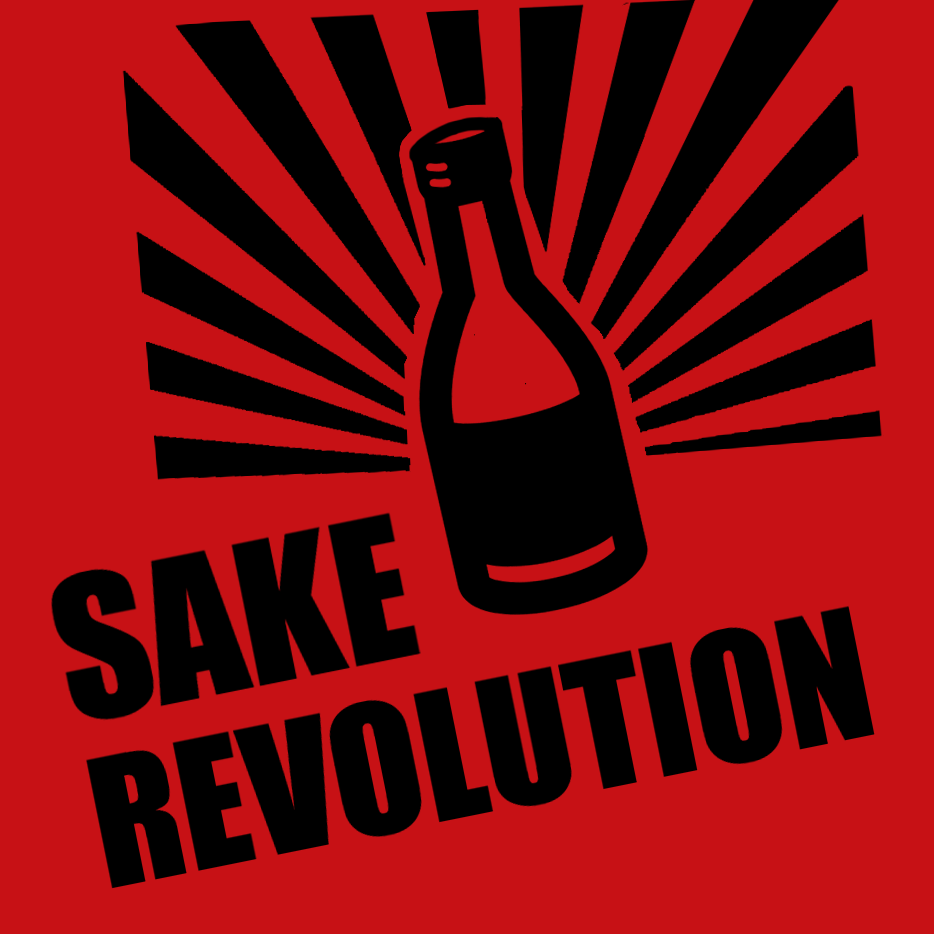The World’s Best Sake?
 Daishichi Myouka Rangyoku.
Daishichi Myouka Rangyoku.
Could it be the World’s Best Saké?
I’m talking #1 on Planet Earth!?
The highest quality in the known Universe!?!
Ladies and Gentlemen, I may not be a sake expert just yet, but one sip and my taste buds told me, in no uncertain terms, this is the best, most complex and richest sake I may ever have in my whole life!!
Phew, now that that is off my chest, I guess I better back up a little bit and tell you how this all came to be…
Sakagura is an amazing subterranean world. It’s just a wonderful place to be. I got on their mailing list and they sent me a notice about a special Daishichi Brewery tasting evening. I wasn’t really sure what to expect, but I booked my reservation right away and Jerin came along for the adventure.
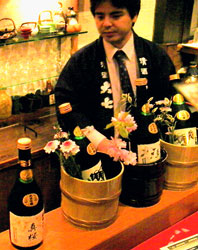 The evening started with a free DaiShiChi Tasting of two sakes. one sip each in a riedel glass. The tasting area was over in the back corner at the bar. The president of Daishichi,
The evening started with a free DaiShiChi Tasting of two sakes. one sip each in a riedel glass. The tasting area was over in the back corner at the bar. The president of Daishichi, Hideharu Ohta was there and he was graciously introducing everyone to his sake. Keita was the nice importer & sake sommelier who was on hand and also helping pour the tastings.
Back in our seats, Jerin and I started with the “Daishichi Tasting Set” ($17). This consisted of 3 Daishichi sakes from their brewery in Fukushima Prefecture: Minowamon Kimoto Junmai Daiginjo, Daishichi Shizen Kimoto, and Daishici Kimoto Honjyozo. You’ll notice that all sakes in the tasting are “Kimoto” sakes. What does this mean? as far as I can tell, Kimoto is a description of the original method of creating a “starter mash” for the sake by mixing rice, koji, and water to a puree BY HAND. This breaks everything down to feed the yeast. The interesting thing here is that Daishichi is well known for using this original and more labor intensive production method. Cool!
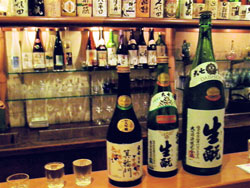 The first sake of the three, Minowamon Kimoto was really a delight! delicious, smooth and clean. The second sake in the tasting was Shizenshu Kimoto, a junmai. The third sake was Daishichi Kimoto Honjyozo. The sakes were presented in small shotglass style cups, filled to the brim. In the Sakagura style, the bottles were left out for examination while our tasting was in progress. this is an excellent custom, as long as the customer knows the bottle is for looking at and not for pouring second helpings. It is really great to look at the bottle. you can see such things as pairing suggestions, SMV, rice type used etc, etc… The samples were small, so I powered thru this tasting pretty quickly. Then the question comes up what to drink next…
The first sake of the three, Minowamon Kimoto was really a delight! delicious, smooth and clean. The second sake in the tasting was Shizenshu Kimoto, a junmai. The third sake was Daishichi Kimoto Honjyozo. The sakes were presented in small shotglass style cups, filled to the brim. In the Sakagura style, the bottles were left out for examination while our tasting was in progress. this is an excellent custom, as long as the customer knows the bottle is for looking at and not for pouring second helpings. It is really great to look at the bottle. you can see such things as pairing suggestions, SMV, rice type used etc, etc… The samples were small, so I powered thru this tasting pretty quickly. Then the question comes up what to drink next…
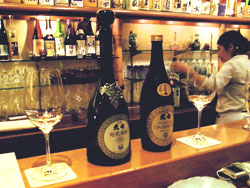 Our friendly sake sommelier/waitress highly recommended the special Sakagura Exclusive Super Rare tasting options that they only had on hand for that night – and only two bottles each. The first was Myouka Rangyoku a.k.a. “Heavenly Flower”. I ordered the “tasting size”… about 1.8 oz for $32. Sounds expensive you say? Well, the 720ml bottle of “Heavenly Flower” costs $460. I thought of it this way… when would I have the chance to sample such a costly sake again?! and you know what? It was worth every penney. Each tiny sip of the Myouka Rangyoku was an honest-to-goodness sake bomb with flavor activating every taste bud. This Trickle Dai Ginjo is also an aged sake from the 2003 vintage. simply beyond amazing.
Our friendly sake sommelier/waitress highly recommended the special Sakagura Exclusive Super Rare tasting options that they only had on hand for that night – and only two bottles each. The first was Myouka Rangyoku a.k.a. “Heavenly Flower”. I ordered the “tasting size”… about 1.8 oz for $32. Sounds expensive you say? Well, the 720ml bottle of “Heavenly Flower” costs $460. I thought of it this way… when would I have the chance to sample such a costly sake again?! and you know what? It was worth every penney. Each tiny sip of the Myouka Rangyoku was an honest-to-goodness sake bomb with flavor activating every taste bud. This Trickle Dai Ginjo is also an aged sake from the 2003 vintage. simply beyond amazing.
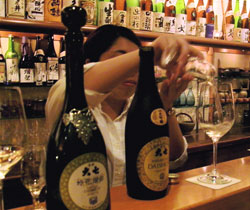 Jerin ordered the tasting size of the super rare Kimoto Junmai Daiginjo Sizuku Genshu (vintage 1990, 1.8 oz, $30). I’ve had aged sakes before.. but they were a dark brown. This sake was amazing in that, even though it was 16 years old, it was more or less clear! I was told this had to do with the purity of the sake that was used to start with. Once I had a sip or two, the simple wafting backdrop of taru (cedar) came through. Again, this shook up my notions of what taru is or what aged sake is. it was very drinkable and Jerin prefered it to the Myouka Rangyoku. I would recommend this as an afterdinner drink. a very special treat to complete a very special meal. We were, however, in the middle of our meal and the 1.8oz serving sizes for these two amazing treats were not filling us up.
Jerin ordered the tasting size of the super rare Kimoto Junmai Daiginjo Sizuku Genshu (vintage 1990, 1.8 oz, $30). I’ve had aged sakes before.. but they were a dark brown. This sake was amazing in that, even though it was 16 years old, it was more or less clear! I was told this had to do with the purity of the sake that was used to start with. Once I had a sip or two, the simple wafting backdrop of taru (cedar) came through. Again, this shook up my notions of what taru is or what aged sake is. it was very drinkable and Jerin prefered it to the Myouka Rangyoku. I would recommend this as an afterdinner drink. a very special treat to complete a very special meal. We were, however, in the middle of our meal and the 1.8oz serving sizes for these two amazing treats were not filling us up.
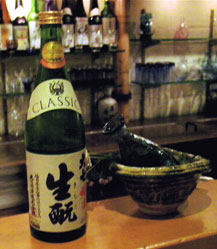 As a final Daishichi adventure for the evening, and coming down off the most complex sake ever, I asked our sommelier for something easy! please give me a daishichi that is accessible, drinkable and easy. She came back to us with a carafe of daishichi “classic”. This junmai sake tasted strict and more acidic, but how could it not coming off heavenly flower?! I grew to enjoy the flavor as we sipped away over the rest of our dinner and through our dessert.
As a final Daishichi adventure for the evening, and coming down off the most complex sake ever, I asked our sommelier for something easy! please give me a daishichi that is accessible, drinkable and easy. She came back to us with a carafe of daishichi “classic”. This junmai sake tasted strict and more acidic, but how could it not coming off heavenly flower?! I grew to enjoy the flavor as we sipped away over the rest of our dinner and through our dessert.
WOW, what an evening. This was such a great introduction to the Daishichi Brewery. It is obvious that Mr. Ohta and everyone at Daishichi take great pride in using the latest technology, milling and bottling methods and combining that with traditional brewing methods to create a very unique, consistant and delightful line of sakes. Thanks to Sakagura for hosting the evening. what a treat. Oh, if any other Sake Brewers out there are reading this and you think YOUR Sake deserves to be named UrbanSake.com’s World’s Best Sake, please send me a sample right away and I will be happy to give you my review!


